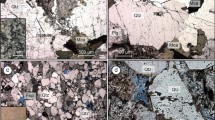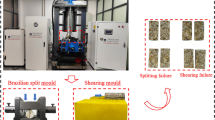Abstract
The dynamic permeability evolution of a fracture is a key scientific problem for fluid flows in rock masses within engineering systems. Understanding the dynamic permeability evolution and its mechanism is conducive to design and operation engineering. The dynamic permeability evolution of a rough granite fracture was revealed by laboratory experiments and numerical models. The permeability evolution of six fractured samples with rough fractures were monitored under 1.9–20 MPa effective normal stresses. The results show that the shearing process significantly affects the permeability and that the variation trend of the permeability depends on the magnitude of the effective normal stress. Under effective normal stresses of 1.9–5 MPa, the permeability is first significantly enhanced and then decreased by shearing. When effective normal stresses of more than 5 MPa are applied, the permeability only shows a decreasing trend. A high effective normal stress not only limits the dilatancy of a fracture but also enhances the formation of fault gouges. The mechanism of the dynamic permeability evolution was revealed by numerical simulations based on the discrete element method. The shearing mechanism includes the sliding mechanism and shearing mechanism. Under a low normal stress, first, the sliding mechanism is dominant and decreases the contact area, which is conducive to establishing a flow channel and increases the permeability. Then, the shearing mechanism becomes increasingly impactful, causing the contact area to increase and the permeability to decrease. Under a high normal stress, the sliding and shearing mechanisms are always engaged, which generates many wear products and reduces the permeability.








(modified from Potyondy and Cundall 2004)

(modified from Itasca Consulting Group 2014)







Similar content being viewed by others
Abbreviations
- A :
-
Area of contact
- Ar:
-
Relative contact area
- E c :
-
Effective modulus of both the particle and parallel bond
- F :
-
Contact force
- \(F_{\text{s}}^{\mu }\) :
-
Greatest value of the shear force at the SJ contact
- \(F_{\text{s}}^{*}\) :
-
Updated shear force at the SJ contact
- F n :
-
Normal component of the contact force
- F s :
-
Shear component of the contact force
- JRC:
-
Joint roughness coefficient
- P p :
-
Pore pressure
- U :
-
Relative displacement
- U n :
-
Normal component of the relative displacement
- U s :
-
Shear component of the relative displacement
- R :
-
Radius of SJ
- R i :
-
Radius of particle i
- T :
-
Tensile strength
- SJ:
-
Smooth joint
- \(Z_{2}\) :
-
Root mean square of the first derivative of the profile
- k n :
-
SJ normal stiffness
- k s :
-
SJ shear stiffness
- k :
-
Permeability
- k 0 :
-
Initial permeability
- k ave :
-
Average permeability
- kn/ks :
-
Ratio of the normal stiffness to the shear stiffness of both the particle and parallel bond
- μ :
-
SJ coefficient of friction
- ψ :
-
SJ dilation angle
- m :
-
Number of sampling points
- n j :
-
Unit normal vector of the joint
- n c :
-
Unit normal vector of a contact
- r min :
-
Minimum particle radius
- r max :
-
Maximum particle radius
- \(y_{i}\) :
-
Elevation of the sampling point
- ∆:
-
Increment
- λ :
-
Radius multiplier of SJ
- \(\Delta x\) :
-
Sampling interval
- σ n :
-
Normal stress
- σ en :
-
Effective normal stress
- σ b :
-
Tensile strength of the parallel bond
- c b :
-
Cohesion strength of the parallel bond
- ϕ b :
-
Local friction angle of the parallel bond
- ρ :
-
Particle density
References
Amadei B, Illangasekare T (1994) A mathematical model for flow and solute transport in non-homogeneous rock fractures. Int J Rock Mech Min 31:719–731. https://doi.org/10.1016/0148-9062(94)90011-6
Asadi MS, Barla GJRM, Engineering R (2012) A bonded particle model simulation of shear strength and asperity degradation for rough rock fractures. Rock Mech Rock Eng 45:649–675
Asadi MS, Barla GJRM, Engineering R (2013a) A laboratory shear cell used for simulation of shear strength and asperity degradation of rough rock fractures. Rock Mech Rock Eng 46:683–699
Asadi MS, Rasouli V, Barla G (2013b) A laboratory shear cell used for simulation of shear strength and asperity degradation of rough rock fractures rock mechanics and rock engineering 46:683–699. https://doi.org/10.1007/s00603-012-0322-2
Bahaaddini M, Sharrock G, Hebblewhite BKJC (2013) Numerical direct shear tests to model the shear behaviour of rock joints. Geotechnics 51:101–115
Bahaaddini M, Hagan PC, Mitra R, Khosravi MH (2016) Experimental and numerical study of asperity degradation in the direct shear test. Eng Geol 204:41–52. https://doi.org/10.1016/j.enggeo.2016.01.018
Bart M, Shao JF, Lydzba D, Haji-Sotoudeh M (2004) Coupled hydromechanical modeling of rock fractures under normal stress. Can Geotech J 41:686–697. https://doi.org/10.1139/t04-018
Barton N, Bandis S, Bakhtar K (1985) Strength, deformation and conductivity coupling of rock joints. Int J Rock Mech Min Sci Geomech Abstr 3:121–140
Cundall PA (2000) Numerical experiments on rough joints in shear using a bonded particle model. In: Lehner FK, Urai JL (eds) Aspects of tectonic faulting: in honour of Georg Mandl. Springer, Berlin, pp 1–9. https://doi.org/10.1007/978-3-642-59617-9_1
Esaki T, Du S, Mitani Y, Ikusada K, Jing L (1999) Development of a shear-flow test apparatus and determination of coupled properties for a single rock joint. Int J Rock Mech Min Sci 36:641–650
Fang Y, Elsworth D, Wang C, Ishibashi T, Fitts JP (2017) Frictional stability-permeability relationships for fractures in shales. J Geophys Res Solid Earth 122:1760–1776
Fang Y, Elsworth D, Ishibashi T, Zhang FS (2018) Permeability evolution and frictional stability of fabricated fractures with specified roughness. J Geophys Res Sol Ea 123:9355–9375. https://doi.org/10.1029/2018jb016215
Faoro I, Niemeijer A, Marone C, Elsworth D (2009) Influence of shear and deviatoric stress on the evolution of permeability in fractured rock. J Geophys Res. https://doi.org/10.1029/2007jb005372
Gangyan GWJ, Yuding Y (1990) An experimental study of naturally cracked rock permeabilty. J Seismol Res 20:319–328
Giger S et al (2011) Design, operation and validation of a new fluid-sealed direct shear apparatus capable of monitoring fault-related fluid flow to large displacements. Int J Rock Mech Min Sci 48:1160–1172
Giwelli A et al (2016) Laboratory observations of fault transmissibility alteration in carbonate rock during direct shearing. Geofluids 16:658–672. https://doi.org/10.1111/gfl.12183
Huang J, Xu S, Hu S (2014) Numerical investigations of the dynamic shear behavior of rough rock joints. Rock Mech Rock Eng 47:1727–1743. https://doi.org/10.1007/s00603-013-0502-8
Ishibashi T, Watanabe N, Asanuma H, Tsuchiya N (2016) Linking microearthquakes to fracture permeability change: the role of surface roughness. Geophys Res Lett 43:7486–7493
Itasca Consulting Group l (2014) PFC (particle flow code in 2 and 3 dimensions), version 5.0 [User’s manual]. Minneapolis
Jaeger JC, Cook NG, Zimmerman R (2009) Fundamentals of rock mechanics. Wiley, New York
Ji SH, Koh YK, Kuhlman KL, Lee MY, Choi JW (2013) Influence of pressure change during hydraulic tests on fracture aperture. Ground Water 51:298–304. https://doi.org/10.1111/j.1745-6584.2012.00968.x
Kamali-Asl A, Ghazanfari E, Perdrial N, Bredice N (2018) Experimental study of fracture response in granite specimens subjected to hydrothermal conditions relevant for enhanced geothermal systems. Geothermics 72:205–224. https://doi.org/10.1016/j.geothermics.2017.11.014
Lambert C, Buzzi O, Giacomini AJC (2010) Influence of calcium leaching on the mechanical behavior of a rock–mortar interface: a DEM analysis. Comput Geotech 37:258–266
Lang PS, Paluszny A, Zimmerman RW (2016) Evolution of fracture normal stiffness due to pressure dissolution and precipitation. Int J Rock Mech Min Sci 88:12–22. https://doi.org/10.1016/j.ijrmms.2016.06.004
Lee HS, Cho TF (2002) Hydraulic characteristics of rough fractures in linear flow under normal and shear load. Rock Mech Rock Eng 35:299–318. https://doi.org/10.1007/s00603-002-0028-y
Nishiyama S, Ohnishi Y, Ito H, Yano T (2014) Mechanical and hydraulic behavior of a rock fracture under shear deformation Earth. Planets Sp 66:108. https://doi.org/10.1186/1880-5981-66-108
Park J-W, Song J-J (2013) Numerical method for the determination of contact areas of a rock joint under normal and shear loads. Int J Rock Mech Min Sci 58:8–22. https://doi.org/10.1016/j.ijrmms.2012.10.001
Potyondy DO, Cundall PA (2004) A bonded-particle model for rock. Int J Rock Mech Min Sci 41:1329–1364
Rong G, Yang J, Cheng L, Zhou C (2016) Laboratory investigation of nonlinear flow characteristics in rough fractures during shear process. J Hydrol 541:1385–1394. https://doi.org/10.1016/j.jhydrol.2016.08.043
Rutter E, Hackston A (2017) On the effective stress law for rock-on-rock frictional sliding, and fault slip triggered by means of fluid injection. Philos Trans A Math Phys Eng Sci. https://doi.org/10.1098/rsta.2016.0001
Shu B, Zhu R, Tan J, Zhang S, Liang M (2019) Evolution of permeability in a single granite fracture at high temperature. Fuel 242:12–22. https://doi.org/10.1016/j.fuel.2019.01.031
Snow DT (1969) Anisotropie permeability of fractured media. Water Resour Res 5:1273–1289. https://doi.org/10.1029/WR005i006p01273
Stober I, Bucher K (2015) Hydraulic conductivity of fractured upper crust: insights from hydraulic tests in boreholes and fluid-rock interaction in crystalline basement rocks. Geofluids 15:161–178. https://doi.org/10.1111/gfl.12104
Takahashi M (2003) Permeability change during experimental fault smearing. J Geophys Res Solid Earth. https://doi.org/10.1029/2002jb001984
Wang GJY, Wang W, Li T (2009) Development and application of an improved numeric control shear-fluid coupled apparatus for rock joint. Rock Soil Mech 30:3200–3208. https://doi.org/10.16285/j.rsm.2009.10.049
Wang G, Zhang X, Jiang Y, Wu X, Wang S (2016) Rate-dependent mechanical behavior of rough rock joints. Int J Rock Mech Min Sci 83:231–240. https://doi.org/10.1016/j.ijrmms.2015.10.013
Witherspoon PA, Wang JSY, Iwai K, Gale JE (1980) Validity of cubic law for fluid flow in a deformable rock fracture. Water Resour Res 16:1016–1024. https://doi.org/10.1029/WR016i006p01016
Xia Caichu SZ (2002) Joint mechanics of engineering rock mass. Tongji University Press, Tongji
Yang Z, Lo S, Di C (2001) Reassessing the joint roughness coefficient (JRC) estimation using Z2. Rock Mech Rock Eng 34:243–251
Yang H, Xie S-Y, Secq J, Shao J-F (2017) Experimental study and modeling of hydromechanical behavior of concrete fracture. Water Sci Eng 10:97–106. https://doi.org/10.1016/j.wse.2017.06.002
Yeo IW, de Freitas MH, Zimmerman RW (1998) Effect of shear displacement on the aperture and permeability of a rock fracture. Int J Rock Mech Min Sci 35:1051–1070. https://doi.org/10.1016/s0148-9062(98)00165-x
Zhang Q, Li X, Bai B, Hu S, Shi L (2018) Effect of pore fluid pressure on the normal deformation of a matched granite. Jt Process. https://doi.org/10.3390/pr6080107
Acknowledgements
This research was supported by the National Key R&D Program of China (no. 2016YFB0600805), the Youth Fund of the National Natural Science Foundation of China (41702289) and the Open Research Fund of State Key Laboratory of Geomechanics and Geotechnical Engineering, Institute of Rock and Soil Mechanics, Chinese Academy of Sciences (no. Z017008).
Author information
Authors and Affiliations
Corresponding author
Ethics declarations
Conflict of interest
The authors declare that they have no conflicts of interest for this work.
Additional information
Publisher's Note
Springer Nature remains neutral with regard to jurisdictional claims in published maps and institutional affiliations.
Rights and permissions
About this article
Cite this article
Shen, H., Zhang, Q., Li, Q. et al. Experimental and Numerical Investigations of the Dynamic Permeability Evolution of a Fracture in Granite During Shearing Under Different Normal Stress Conditions. Rock Mech Rock Eng 53, 4429–4447 (2020). https://doi.org/10.1007/s00603-020-02074-7
Received:
Accepted:
Published:
Issue Date:
DOI: https://doi.org/10.1007/s00603-020-02074-7




